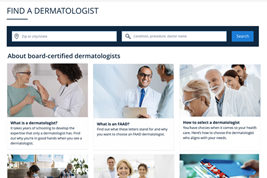Get started as a practicing dermatologist
Starting your career as a dermatologist is exciting, but it’s also packed with many decisions. Should you join a group or go solo? What should you look for in a job offer? How do you even set up a practice?
This guide provides AAD resources to help you get started. If you choose to join a group, we can help you find the right job, ask the right questions of your potential employer, and understand your employment contract. If you open a solo practice, we offer guidance on setting up your office, building compliance programs, and hiring and retaining staff.
If you choose to join a group or institutional practice, the AAD can help you with:
If you are going into solo practice, the AAD provides resources on:
Choose the kind of dermatology practice that fits you
Choosing a practice that fits you is central to launching your dermatology career, with implications for your clinical practice, compensation, and work-life balance. This guide will help you understand the benefits and challenges associated with different types of practice.
Independent
Independent practices typically involve greater autonomy, flexibility, and control over clinical and business decisions, but with longer work hours and increased business responsibilities and risk.
Solo practice: Operating your own clinic offers a high degree of independence but requires managing both clinical care and business operations.
Cash and concierge: These practices operate outside of traditional insurance systems and typically involve direct payment from patients, relying on strong, ongoing patient relationships.
Group
Group practices usually involve collaboration and sharing of resources but may offer reduced individual autonomy and control.
Small group: These practices with fewer than 15 dermatologists may offer administrative support and opportunities for shared decision-making.
Large group: These larger multisite practices typically provide centralized administrative support standardized operations which can help support work-life balance though they may involve reduced physician autonomy.
Institutional
Large academic or government institutions may offer opportunities for research or more complex cases, often with good benefits and work-life balance. However, they may offer less independence and lower salaries.
Academic medical center: These medical centers often involve teaching, research, and complex cases along with structured policies, lower salaries, and reduced autonomy.
Veteran Affairs hospital: VA hospitals serve veterans, often with opportunities for research and exposure to a diverse range of cases, in structured systems with set compensation models.
See all our resources on practice types for information about other practice types. If you choose to open your own practice, please see our resources on setting up policies and procedures. If you need to find a job in a group or institutional practice, please proceed to the next section.
Find a job in dermatology
Use the AAD’s resources to find a job that aligns with your career goals. AAD Career Compass is a job board for dermatology job-seekers. Review open dermatology positions, use career resources, and more.
Review questions to ask potential employers
See our questions to ask a potential dermatology employer before you conduct interviews. Areas for consideration include compensation and benefits, staff and technology supports, schedule and workload flexibility, and business interests.
Understand your employment contract
Your employment contract ultimately governs the terms of your work. Use our resources to understand the different parts of an employment contract. Our guidance points to contract language with a direct impact on your work, including bonus terms, business expenses, performance evaluations, and more.
After you have signed the contract, you can see our tips for joining an established practice.
Set up policies and procedures
Setting up a new practice requires establishing policies and procedures that comply with the law and protect your business. This documentation supports practice operations and compliance with government regulations. Training staff on policies and procedures promotes best practices while protecting the business.
Laboratory compliance (CLIA)
Patient privacy (HIPAA)
Cybersecurity and identity theft
Workplace safety (OSHA)
Emergency response
Accessibility (ADA)
Family leave (FMLA)
Laboratory compliance (CLIA)
The Academy advocates for CMS to recognize the value of dermatologist expertise. We provide detailed guidance on lab regulations and work to reduce administrative burdens related to lab certification and oversight.
Patient privacy (HIPAA)
Safeguarding patient privacy is imperative, both by law and to protect your practice. The Academy offers practical advice on meeting HIPAA requirements and protecting patient data. We also keep you informed when regulations change, such as rules around promptly providing patient access to lab reports.
Cybersecurity and identity theft
Medical practices have become prime targets for cybercrime, especially ransomware attacks. See our 6 tips for improving cybersecurity in your practice, and set good policies on bringing your own device (BYOD) to work.
More than just your practice data is at risk; cybercriminals can also steal your identity. Physicians are attractive targets for cybercriminals because they are high-income earners who tend to have large data footprints. Protect yourself with our guidance on preventing identity theft.
Workplace safety (OSHA)
Dermatology practices must comply with OSHA requirements, including hazard identification and prevention, establishing a safety program, and training for physicians and staff.
Read guidance on how dermatology practices can meet OSHA requirements, or access our other OSHA resources. The AAD also provides resources on preventing workplace violence, which is higher than average in health care.
Emergency response
A little planning goes a long way in an emergency. Hear from practicing dermatologists about how they plan for emergency and recover from disaster. Or access our guidance on disaster risk assessment and recovery, including the need to secure electronic health information.
Accessibility (ADA)
Dermatology practices also must comply with the Americans with Disabilities Act (ADA). The Academy provides guidance on the ADA obligations of dermatology practices for patients and staff. We also offer information on ADA requirements for website accessibility.
Family leave (FMLA)
Providing family leave is required by law if your practice employs more than 50 people. Employees also have to meet certain requirements. However, even if you are not required to offer family leave, it may benefit your practice to do so. The law also requires accommodations for pregnant or lactating employees.
Optimize your practice
Whether you’re opening a new practice or looking to make improvements to an existing office, the Academy’s resources can help. Our office optimization resources provide tips on how each room of the practice should be equipped and configured, from the waiting room, to exam rooms, to your own office. We also provide guidance on tech solutions to improve efficiency in your practice.
Hiring and retaining the right staff is also crucial. The Academy offers practical guidance on staffing, including onboarding and HR fundamentals. We also offer resources for work-life balance and burnout prevention.

This content was created with the particular needs of early-career dermatologists in mind. See the rest of our Career Launch resources for young physicians.
 Find a Dermatologist
Find a Dermatologist
 Member directory
Member directory
 AAD Learning Center
AAD Learning Center
 2026 AAD Annual Meeting
2026 AAD Annual Meeting
 Need coding help?
Need coding help?
 Reduce burdens
Reduce burdens
 Clinical guidelines
Clinical guidelines
 Why use AAD measures?
Why use AAD measures?
 Latest news
Latest news
 New insights
New insights
 Physician wellness
Physician wellness
 Joining or selling a practice?
Joining or selling a practice?
 Promote the specialty
Promote the specialty
 Advocacy priorities
Advocacy priorities
